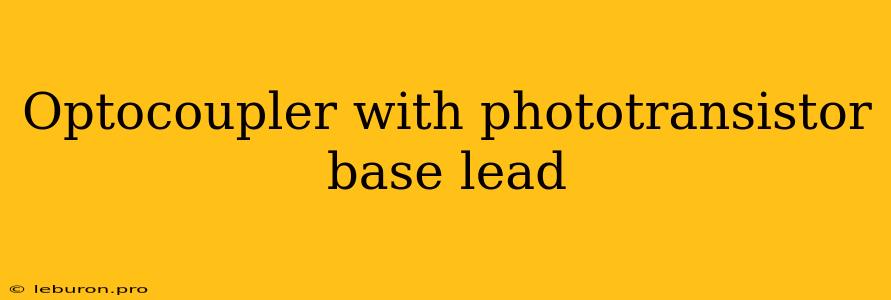Optocouplers, also known as optical isolators, are essential components in electronic circuits, providing electrical isolation between two circuits while maintaining communication. They play a vital role in various applications, from industrial control systems to consumer electronics. This isolation is achieved through the use of light, eliminating the risk of ground loops and other potential electrical interference issues. At the heart of an optocoupler lies a phototransistor, a semiconductor device that converts light energy into electrical current. Understanding the role of the phototransistor base lead is critical for effective implementation of optocouplers in circuit design.
Understanding the Optocoupler and Phototransistor Base Lead
An optocoupler typically consists of a light-emitting diode (LED) and a phototransistor, encapsulated in a single package. The LED emits light when forward-biased, and this light is directed towards the phototransistor. The phototransistor, in turn, converts this light into an electrical current, acting as a switching device. The phototransistor base lead is a critical element in this process, playing a key role in controlling the flow of current in the phototransistor.
How the Phototransistor Base Lead Works
The phototransistor base lead is analogous to the base lead in a traditional bipolar junction transistor (BJT). In a BJT, a small current applied to the base can control a much larger current flowing between the collector and emitter. Similarly, in a phototransistor, light acts as the input signal. When light falls on the phototransistor, it creates electron-hole pairs in the base region, generating a base current. This base current, in turn, controls the flow of a much larger current between the collector and emitter of the phototransistor.
Key Considerations
- Light Sensitivity: The sensitivity of the phototransistor to light directly affects the base current and ultimately the collector-emitter current. Higher sensitivity means a smaller amount of light is required to generate a significant base current.
- Current Gain: The phototransistor's current gain (often denoted as hFE) indicates the ratio of collector current to base current. A higher current gain means that a small base current can control a larger collector current, providing amplification.
Applications of Phototransistor Base Lead in Circuit Design
The phototransistor base lead provides a crucial point for controlling the phototransistor's operation, enabling various circuit design possibilities:
1. Signal Isolation:
- The phototransistor base lead is crucial for isolating circuits from high voltage or noisy signals. By using an optocoupler, the LED side can handle high voltages or noisy signals, while the phototransistor side remains unaffected.
- This isolation is particularly important in applications like medical devices, industrial control systems, and automotive electronics, where safety and reliability are paramount.
2. Logic Level Conversion:
- The phototransistor base lead can be used to convert logic levels from one circuit to another. For example, a high-voltage logic signal can be converted to a low-voltage logic signal by appropriately choosing an optocoupler with suitable light sensitivity.
- This feature is crucial for interfacing different types of logic families and ensuring compatibility between systems.
3. Switching Applications:
- The phototransistor base lead can act as a switch. By controlling the light incident on the phototransistor, the collector-emitter current can be switched on or off.
- This capability is used in applications such as:
- Solid-State Relays: Optocouplers are employed as solid-state relays, providing a non-contact switching mechanism with faster response times and longer lifetimes compared to mechanical relays.
- Motor Control: Optocouplers can be used to control motors, providing isolation between the control circuitry and the motor.
4. Timing Circuits:
- The phototransistor base lead can be used to create timing circuits. By varying the amount of light incident on the phototransistor, the time constant of the circuit can be controlled.
- This technique is useful for applications like pulse generation, delay circuits, and timing control in various electronic systems.
Practical Considerations for Using Phototransistor Base Leads
While the phototransistor base lead offers numerous advantages, there are some practical considerations to keep in mind:
- Reverse Breakdown Voltage: The phototransistor, like any other transistor, has a reverse breakdown voltage. Exceeding this limit can damage the device. Therefore, it's important to ensure that the reverse voltage across the collector-emitter junction remains below the specified limit.
- Operating Temperature Range: The performance of the phototransistor is affected by temperature variations. The operating temperature range of the optocoupler should be considered in the circuit design to ensure reliable operation.
- Data Sheet Review: Before using an optocoupler, it's crucial to carefully review the datasheet. The datasheet provides detailed information about the phototransistor characteristics, including light sensitivity, current gain, response time, operating temperature, and reverse breakdown voltage.
Conclusion
The phototransistor base lead is an indispensable component in optocouplers, providing a means to control the flow of current in the phototransistor. By understanding the principles behind this lead and its applications, circuit designers can leverage the benefits of optocouplers for signal isolation, logic level conversion, switching, and timing circuits. The versatility and reliability of optocouplers, combined with the control offered by the phototransistor base lead, make them an integral part of modern electronic systems across various industries.
